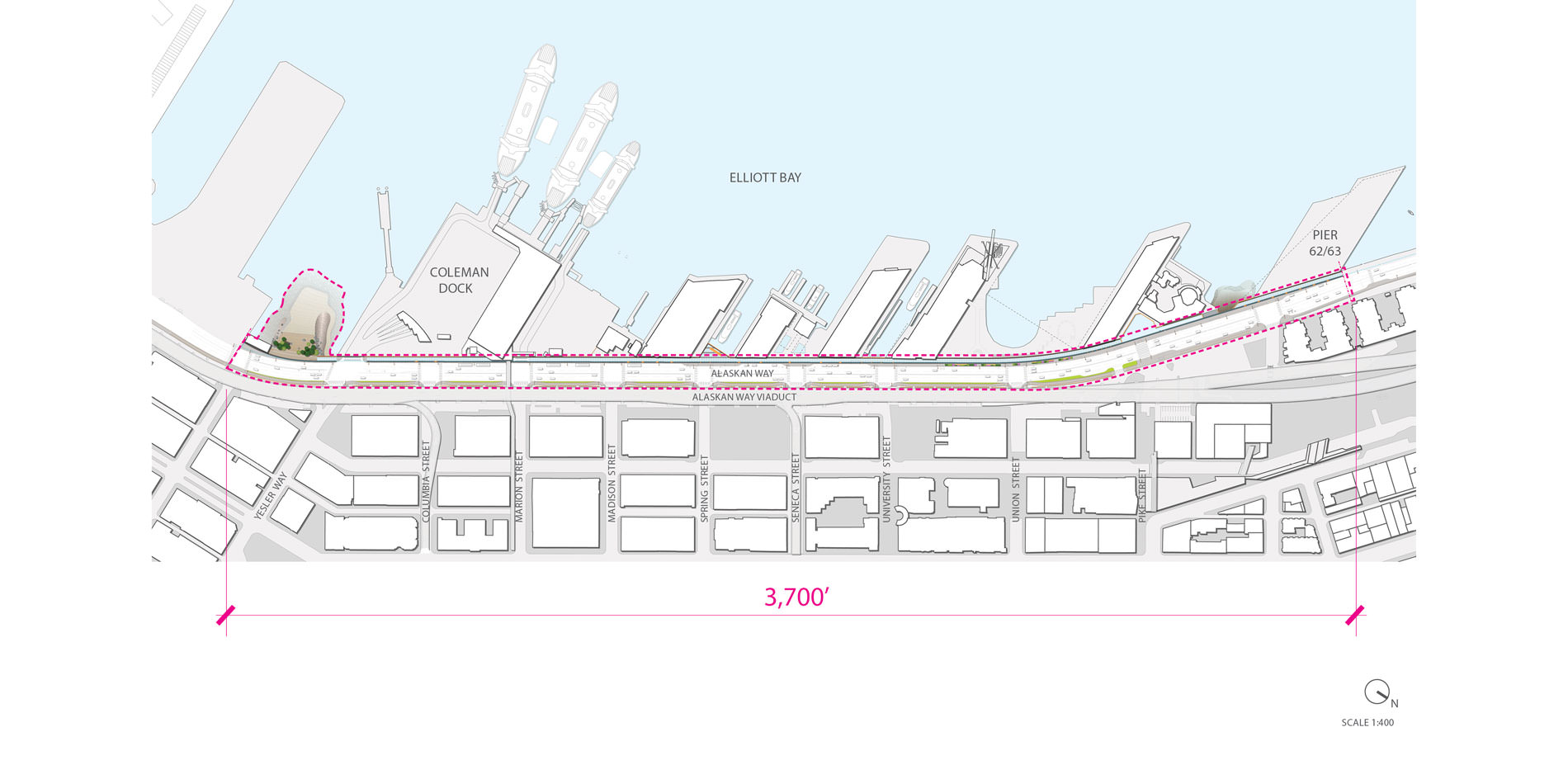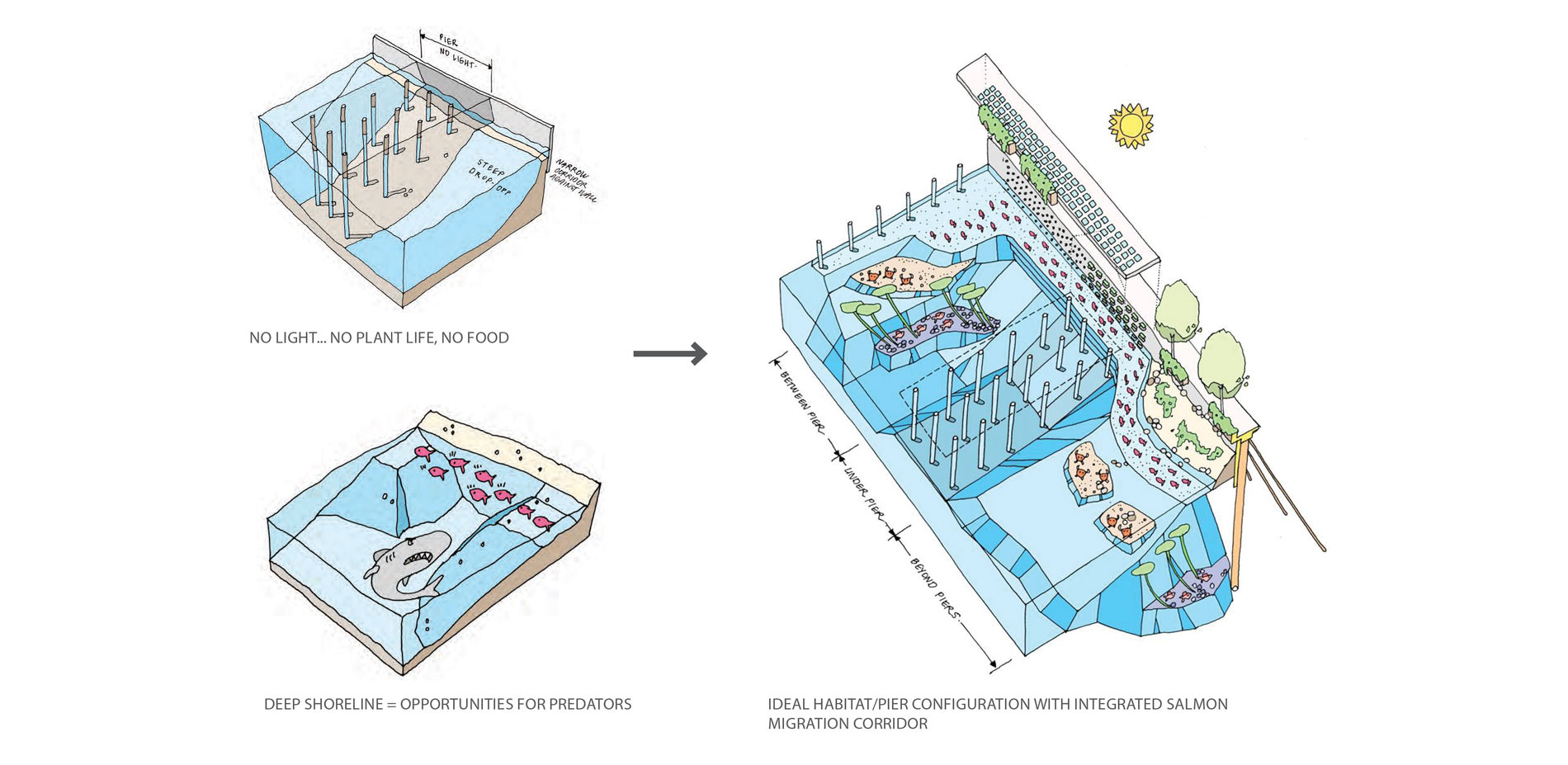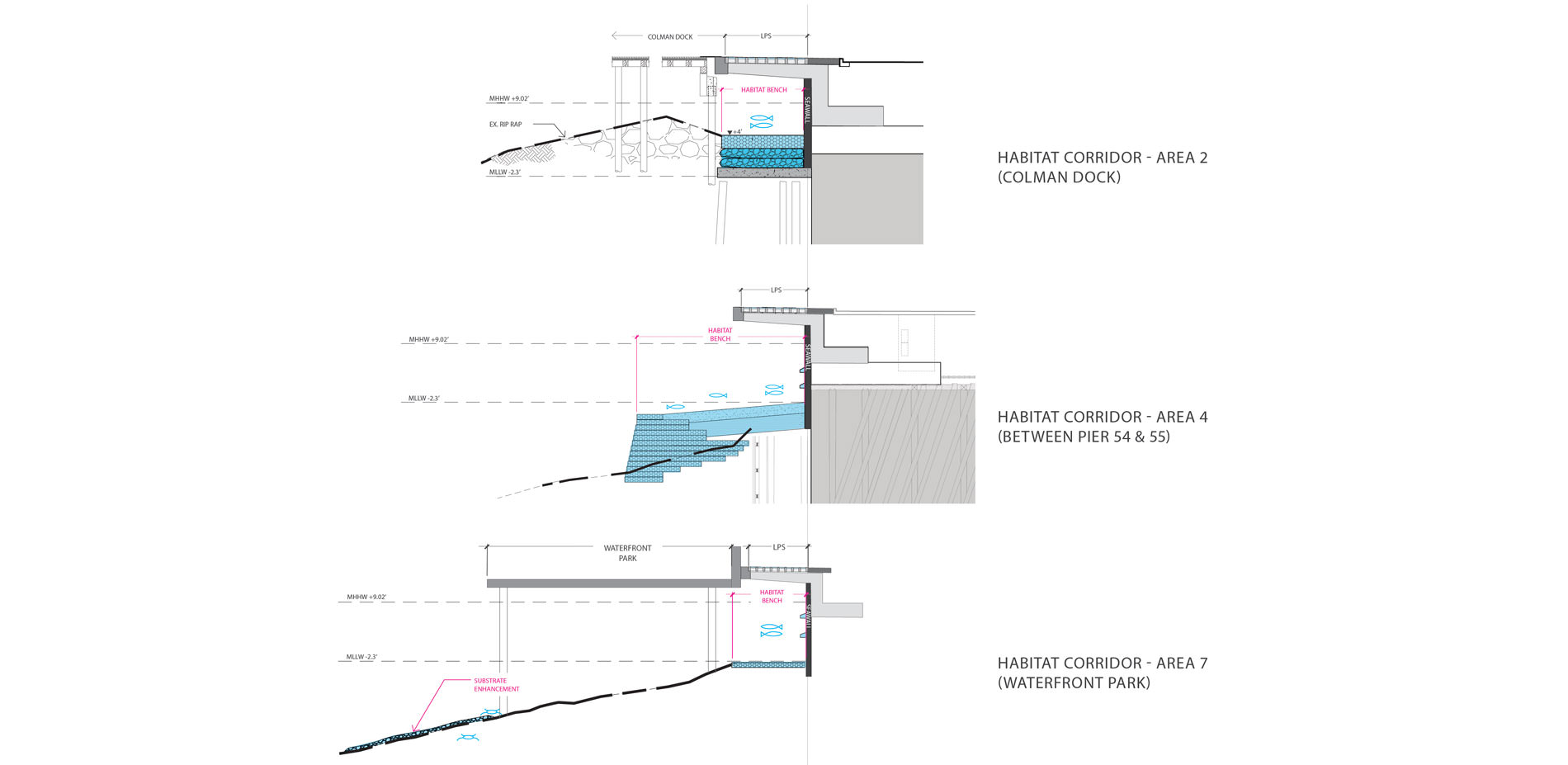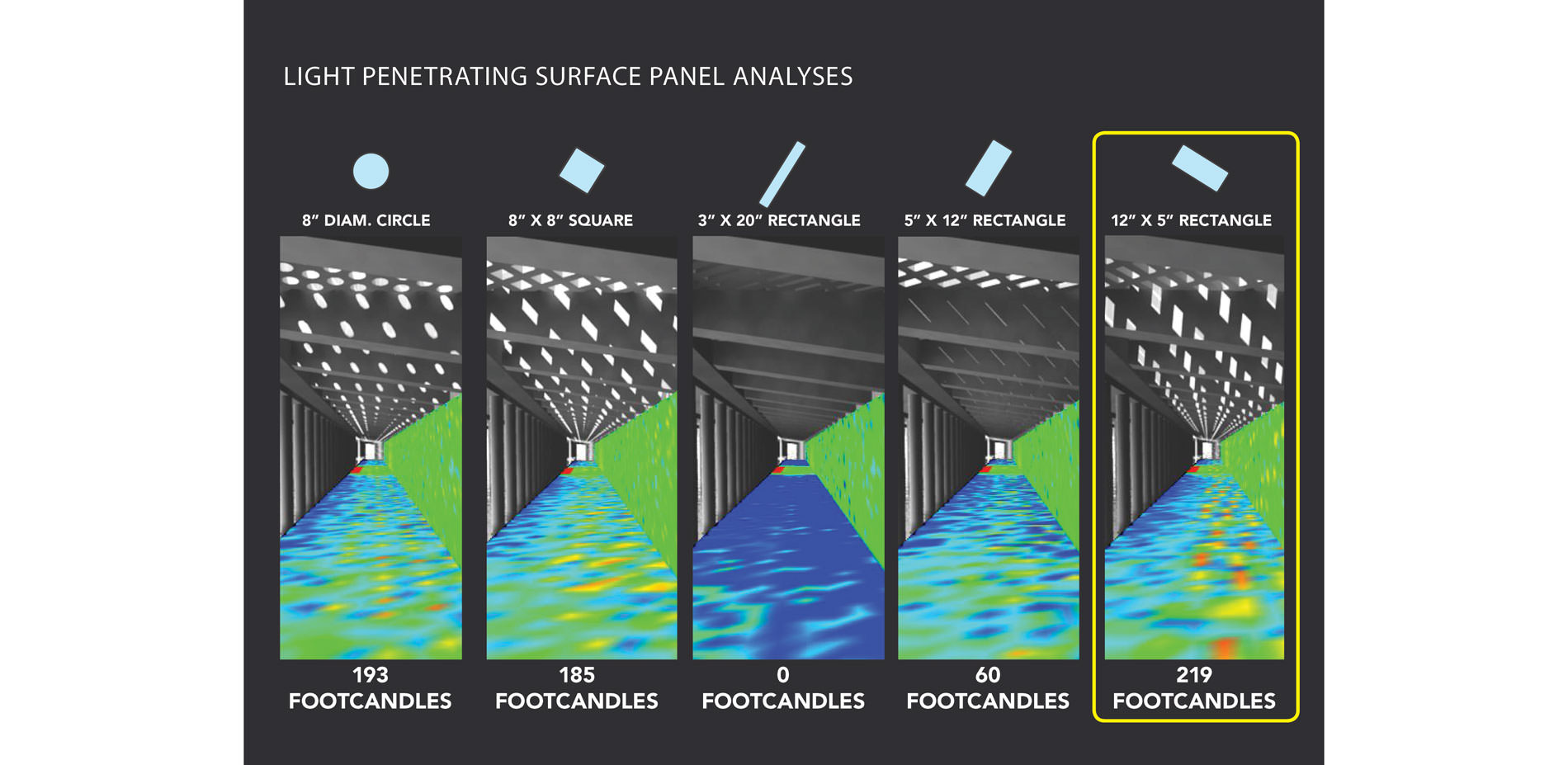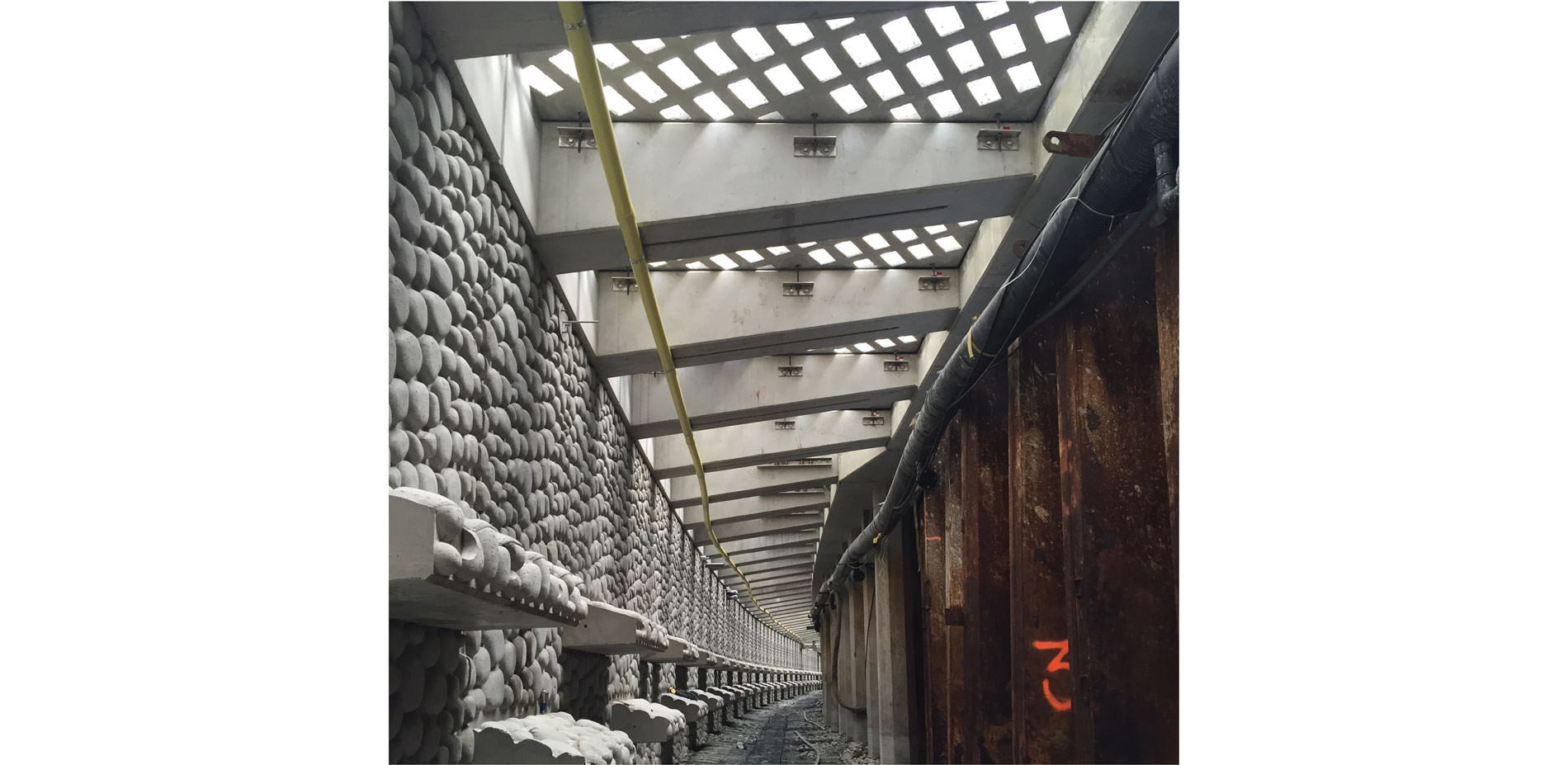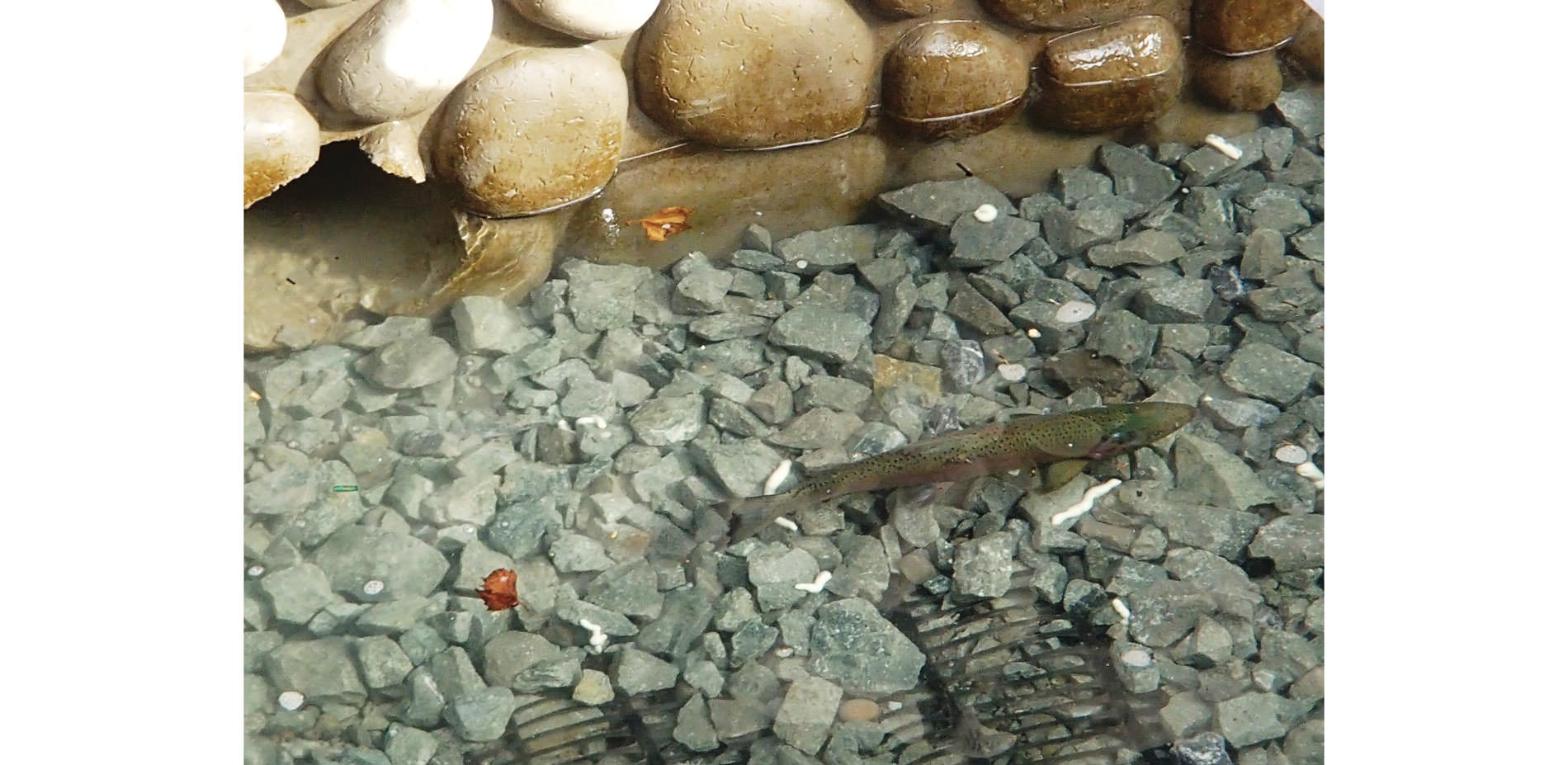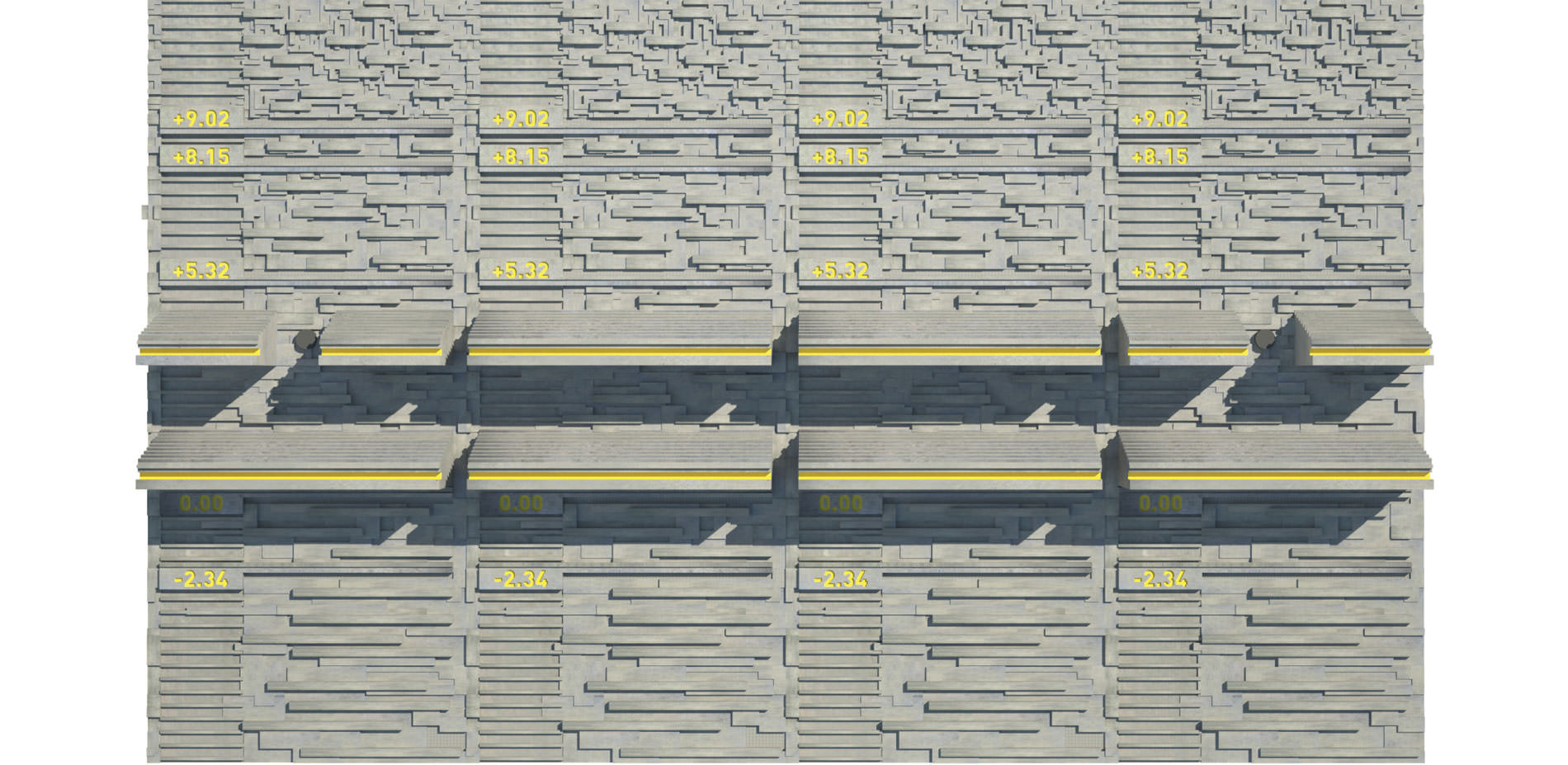Central Seawall Project
Honor
General Design
Seattle, WA, USA | James Corner Field Operations LLC | Client: Seattle Department of Transportation
It’s a major engineering project, and it was a landscape architect who led the group of engineers to resolve a major problem.
- 2017 Awards Jury
PROJECT CREDITS
Urban Design, Landscape Architecture
- James Corner Field Operations (Tatiana Choulika, ASLA, Principal)
Prime Firm, Program Manager, Design Manager, Permitting, Environmental Documentation, Procurement, Utilities Engineering, Geotechnical Engineering, Landscape Architecture, and Structural Engineer
- Parsons Corporation
Lead Engineer for Public Realm and Habitat Design Integration
- Magnusson Klemencic Associates
Civil and Drainage Engineer
- Perteet
- SvR
Coastal Engineer
- Moffatt & Nichol
Additional Structural Engineers
- COWI North America (formerly Ben C. Gerwick, Inc.)
- Exeltech Consulting, Inc.
Geotechnical Engineer
- Shannon & Wilson, Inc.
Habitat Engineer
- Hart Crowser
Local Landscape Architect
- Harrison Design Landscape Architecture
Artist
- Haddad/Drugan (Laura Haddad)
Construction Management
- Jacobs Engineering Group Inc
PROJECT STATEMENT
Seattle’s Central Seawall Project replaced 3,700 linear feet of derelict seawall with a new state-of-the-art, seismic-resistant seawall that is seamlessly integrated with an unprecedented salmon migration corridor, an enhanced tidal marine environment, and an updated pedestrian promenade. The Central Seawall Project is a massive urban infrastructure project which addresses current issues of sea level rise, ecology and aquatic habitat rehabilitation while in the center of a large port city.
The Central Seawall Project is unique among public realm projects due to the high level of collaboration between landscape architecture, civil/structural/marine engineering, infrastructure specialists, and aquatic habitat specialists. Innovative habitat creation is paired with integrated public realm design, which both contribute to the health of marine life while positively engaging the public in understanding all issues at stake. The result is a new model for infrastructure investment that benefits the city, the public, and the ecosystem.
PROJECT NARRATIVE
Design Context
The original Seattle Seawall was built in bits and pieces between 1920 and 1936 and held a quarter million cubic yards of random fill placed behind it to provide level ground near shore.
For 75 years, Seattle’s downtown waterfront seawall withstood erosive tidal forces, wind-driven waves, and underground marine borers. After the 2001 Nisqually earthquake, concerns about the structural integrity of the old seawall arose and in 2004 city inspectors found that 40% of the wall’s Ekki wood boards had been damaged by borers. Furthermore, liquefiable soils surrounding the seawall increased the risk of failure in the next major earthquake. The City of Seattle’s Department of Transportation developed the Central Seawall Project (CSP) to replace 3,700 linear feet of the seawall—the City’s largest piece of infrastructure—with a state-of-the-art, seismic-resistant version designed to last at least 75 years more.
At the same time, the City of Seattle had embarked on a comprehensive redesign of its central waterfront, the centerpiece of downtown. The City saw an opportunity to integrate the two separate but adjacent projects, the CSP rebuild and the overall Central Waterfront design. Since the CSP was on an accelerated schedule, the lead Landscape Architect and Urban Designer for the Central Waterfront was asked to collaborate with the engineering-led CSP team in order to avoid re-doing portions of the waterfront and achieve a unified, cohesive public realm once all stages of the Central Waterfront project were complete.
The result is a new state-of-the-art, seismic-resistant seawall that is seamlessly integrated with an unprecedented salmon migration corridor, an enhanced tidal marine environment, and the first portion of the Central Waterfront’s Waterfront Promenade.
The CSP begins Seattle’s transformation of its waterfront by updating this critical pedestrian link between downtown Seattle, nearby neighborhoods, and waterfront piers, shops, and parks. With the CSP’s successful completion, the full Central Waterfront implementation can move forward without delay or risk of severe damage in an earthquake.
Design Brief
The City’s goals for the CSP were clear: provide a new, earthquake-resistant seawall; improve the near-shore marine environment; re-establish a long-interrupted salmon migration route; create a high-quality pedestrian promenade above the seawall that would be integrated with the overall Central Waterfront design.
Design Intent
- Re-establish a long-interrupted salmon migration route
When Seattle’s waterfront was urbanized, many aspects of the area’s native intertidal habitat were lost, including sloping beaches, crevices, and vegetated hiding places for not only salmon, but other fish and marine creatures. Over the decades, 90% of Seattle’s central waterfront shoreline had become covered by piers and other overwater structures, creating an underwater environment of dark, steep canyons that were nearly impossible for juvenile salmon to navigate. Salmon are integral to the identity and economy of Seattle and the Pacific Northwest, with critical importance to the environment, tribal traditions and livelihood, local and national industry, residents, and tourism, and the decline in salmon population was of deep concern to many stakeholders.
To re-create the salmon’s migration route, the amount of natural light reaching the near-shore migration corridor beneath the proposed pedestrian promenade had to be increased. Habitat like this had never been designed before, and as such, little scientific research was available into the light levels that migrating juvenile salmon require. The design team was charged with providing “as much light as possible”.
Off-the-shelf light-penetrating surface (LPS) options were deemed to offer insufficient light levels, so a custom system was designed. After testing and considering many solutions, including electric lighting, openings through a cantilevered sidewalk, and steel grating, the design team determined that the best way to balance the needs of the public space above with the salmon corridor below was using a system of glass pavers cast into a concrete sidewalk structure.
The custom solution features precast concrete LPS panels with glass pavers specifically shaped, oriented, and positioned to provide optimal natural light into the salmon corridor while also seamlessly connecting to the future Waterfront Promenade design and paving.
The LPS is paired with a habitat bench, which raises the seabed, allowing juvenile salmon to swim without struggling against deep currents. Together, these elements re-create native shoreline characteristics in a highly urban setting, guiding and protecting migrating salmon.
- Improve the near-shore marine environment
Another component of the habitat corridor is the system of custom seawall face panels. Heavily textured precast concrete face panels encourage the growth of marine life and provide feeding grounds for the migrating salmon. These panels are the only part of the seawall that is visible to the public, and the City saw them as an opportunity to enhance the public realm through creative design. Two types of custom face panels were developed, one by the Landscape Architect and another by artist Laura Haddad. In order to ensure that these custom panels would adequately foster marine life, the Lead Engineer for Public Realm and Habitat Design Integration (LEPR) developed the first-ever set of marine surface texture design guidelines, detailing the technical design criteria for the 2-inch-thick “texture zone” and habitat shelves on the face panels. The Landscape Architect, through a series of design iterations, 3D-modeling, and surface texture analysis, created an intricate and visually-compelling panel that is currently successfully hosting marine life.
By reversing seven decades of declining waterfront conditions, the CSP’s habitat corridor is a huge step towards revitalizing the area’s salmon population and marine life. Signs of hope for the future of Puget Sound’s 27 threatened or endangered salmon species are already appearing, as last fall, shortly after the marine mattresses and wall face panels were installed, Seattle DOT staff were already observing entire schools of fish.
- Create a high-quality pedestrian promenade
The CPS’s pedestrian promenade features the LPS panels, which are part of the sidewalk, as well as cast-in-place concrete, above-grade planters with native and climate-appropriate species, wide benches made from reclaimed ship timbers, and a vehicular crash-rated custom-designed railing. The LPS panels will remain in place, with their pattern corresponding to the future Waterfront Promenade’s layout. The planters and benches are temporary and will be repurposed into the greater Waterfront Promenade once the Alaskan Way Viaduct is demolished and construction begins on the final implementation of the Central Waterfront.
Materials and Installation Methods
The seawall and LPS panels are built from precast concrete, installed during carefully phased construction that allowed major traffic arteries and waterfront businesses to remain operational throughout the process. The construction schedule was also coordinated with salmon migration periods, tourist season, and pier owner requirements.
Precast concrete face panels were cast from formliners created from 3D Rhino models.
Collaboration with the Client and Other Designers
In this unique and highly collaborative project, the Landscape Architect worked daily with the CPS LEPR to incorporate Central Waterfront design concepts into the fast-paced delivery of the CSP design, including integration of all urban design, art, landscape, and habitat components.
The Landscape Architect’s design of the size, shape, and layout of the LPS panels was put through rigorous testing by the LEPR, who analyzed over 35 options and simulated light penetration levels with 3ds Max software. Through this process, project stakeholders were convinced that the custom LPS panels would provide sufficient lighting levels and establish a high level of design quality for the future Central Waterfront public realm.
A similarly rigorous process was followed for the seawall face panels, during which highly-detailed 3D models were analyzed by the LEPR to determine whether they met benchmarks for ideal habitat by providing nooks and crannies that are easy for algae, starfish, and other marine species to inhabit, as well as to understand manufacturing implications, tolerance variability, expected formliner life, and cost relative to the off-the-shelf cobblestone alternative.
PRODUCTS
Product Sources: FURNITURE
- Wood benches: custom (reclaimed Douglas fir supplied by Accents of Wood, fabrication by Terra Dynamics)
- Landscape logs: custom (reclaimed Douglas Fir
Product Sources: FENCES/GATES/WALLS
- Vehicular crash-rated railing: custom fabricated steel with Tyler© Drylac© coating
Product Sources: HARDSCAPE
- LPS panels: custom (fabricated by APS Architectural Prescast Structures)
- Cast in place concrete sidewalk
Product Sources: OTHER
- Seawall face panel accent paint: Interzone©954 with Ceilcote© 680M Primer
- Marine mattress structural geogrid: Tensar© Integrally Formed Structural Ge
